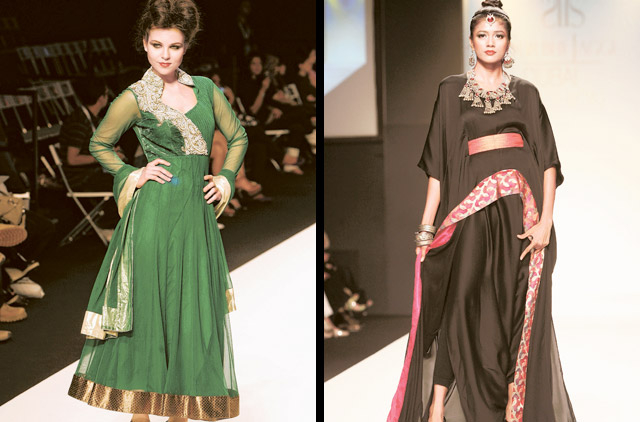First the good news: the last day of Dubai Fashion Week autumn-winter 2011 ended with a bang on Saturday.
The grand finale by Indian designer Rajesh Pratap Singh, which began fashionably late, saw a full house (a rarity this season) and his creations were a cut above the mark (another rarity).
The bad news? A stellar ending does not necessarily mean that the event in its entirety was a success. Poor audience turn-out, empty buyer stands and collections that were in dire need of editing, smart-tailoring and snipping off of loose ends (yes, there were a few dresses spotted on the runway with threads hanging off) were a part of this season's reality.
Quiz the DFW organisers about it and you are immediately met with a spiel on "vacuum because of lack of visibility" and "change in venue". The fashion event was held for the first time in the highly commercial and business-centric Zabeel Hall at the Dubai World Trade Centre, as opposed to a posh hotel like Atlantis, where the white tent was erected last season.
"The empty seats could be because DFW is a trade venue," said Rohit Sabikhi, DFW event director. "The local mindset of the people here is an evening out at a plush hotel is what fashion week is all about. So, it takes time for people to accept any kind of change. We are trying to get the balancing act between trade and sheen right."
Though their vision of striking a balance is laudable, many felt that the latest DFW edition lacked not only sheen but substance.
Show director Marc Robinson adopts a harsher stance. "There is no point in pulling wool over people's eyes. This season has been a big disappointment and I wonder why. Is it the location? You have to remember this is a fashion event and not a wedding where they are obligated to make an appearance."
Changes
He added that Capital Marketing chairman Manoj Bhojwani has the vision and attitude to rectify matters. The Dubai-based media company purchased the operating rights to DFW in 2010. In an interview with tabloid! after the transition last year, Bhojwani had revealed his plans to curb the "Indianising of DFW" and to include a healthier mix of nationalities. Making room for more local designers was also on his agenda.
To an extent, he has delivered on this. This season saw a strong accent on Arabic abaya fashion, like on the final day of DFW where five of the seven presentations were abayas.
"We are trying to bring in a lot of local content. Last season we had 10 GCC designers, this season we have 14. Last season we had five Emirati designers and this year we have 12. It's just the beginning and as you know any change takes a long time to be accepted," said Bhojwani.
Emirati designer Lamees Al Hajiri, who made her DFW debut on Saturday, agrees.
"Yes, I was disappointed by the turn-out and lack of buyers, media etc. But after all, this is a new event and fashion is a growing industry in Dubai. So it will take time to pick up. Give it time."
According to sources, there were only 39 registered buyers this season, out of which many failed to follow up on the registration.
"DFW has reached a do-or-die situation. It has to deliver next time. This is a wake-up call," added Robinson.













